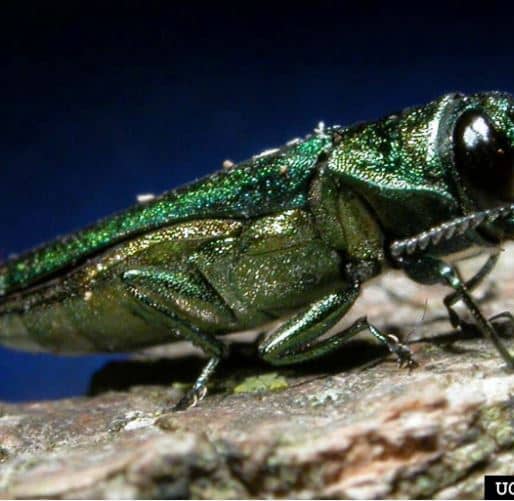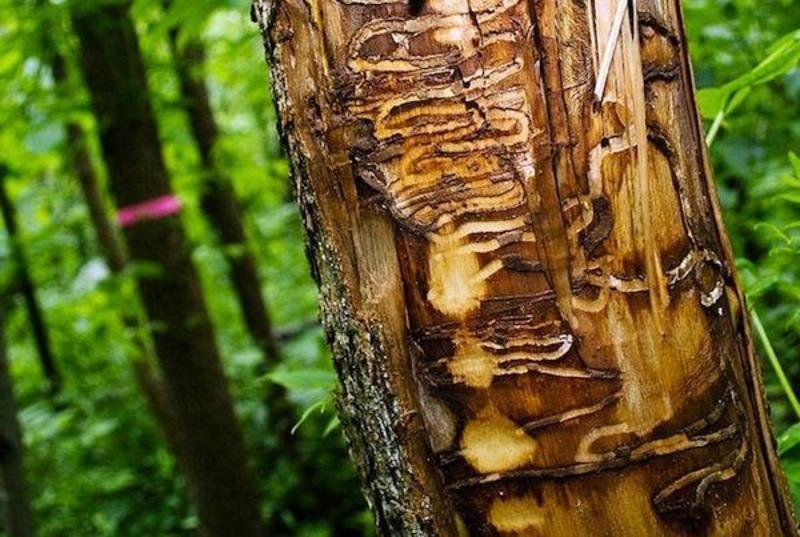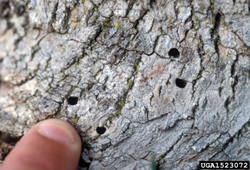THE EMERALD ASH BORER IN OKLAHOMA
It killed millions of ash trees across the Midwest and is now considered the most destructive forest pest in North America. The Emerald Ash Borer (EAB) is an invasive, wood-boring beetle doing some serious damage to ash trees across the country.

The Emerald Ash Borer is a small, metallic green beetle destroying ash trees.
It likely arrived in the United States accidentally in packing material from Asia and was first discovered in Michigan in 2002. Since then, it has spread to twenty-five states and Canada. It was first discovered in Oklahoma in October 2016 in Delaware County and will likely make its way towards Tulsa. The beetles are approximately 1/2 an inch long and metallic green in color with a coppery red or purple abdomen. Trees infected with EAB can die within 1-4 years depending on the size and health of the trees.
SIGNS
There are several signs of EAB to keep an eye out for. Because EAB larvae bore into the outer layer of a tree to feed, it damages the tissues responsible for transporting water and nutrients to the tree. These wounds result in blocked circulation and lead to canopy thinning or dieback, usually at the top 1/3 of the canopy. When feeding, the larvae leave S-shaped galleries underneath the bark. Split bark or bark deformities may be visible over the galleries.
Once the larvae have grown into adults, it leaves D-shaped exit holes visible on the outside of the trunk and chews on the leaves leaving small cuts behind.

S-shaped galleries created by EAB larvae visible when the bark is peeled back.

Small, D-shaped exit holes created by the Emerald Ash Borer.
Trees impacted by EAB may also exhibit stress-induced secondary shoots on the trunk or limbs as the tree tries to outgrow the damage. Increased woodpecker activity may also be a sign of EAB as woodpeckers are attracted to EAB larvae.
HOW IT SPREADS
Wherever EAB is known to occur, the beetles can be expected to have dispersed beyond the area to continue infestation. Though the adult beetle can fly up to several miles, it will usually stay within the vicinity of the tree from which it developed. Unfortunately, because the beetle develops under the bark of ash trees, it can be difficult to detect signs of EAB when it is in low populations and by the time there are signs, it is often too late. It is important to note that while the beetle targets stressed trees, healthy trees are susceptible as well. If one ash tree on a property is infested, it is highly likely other ash trees are at risk.
TREATMENT
Treatment of EAB has been largely unsuccessful. Systemic insecticides may be injected into a tree but it must be done as a preventative measure or at the very early stages of an EAB infestation, which is difficult to detect. Even so, its effects don’t last long, is approximately one to two years, and it’s expensive. In most cases, even a tree treated for EAB will die within several years and removal is the only option. Extreme weather temperatures will not kill the beetle. Unfortunately, ash trees in North America have very little resistance to the non-native beetle and millions of more ash trees are expected to fall victim to EAB.
CONTACT A TULSA ISA CERTIFIED ARBORIST
Though EAB hasn’t yet made it way to Tulsa County (according to the United States Department of Agriculture), it is important to keep an eye out on your trees. There are other types of borers that have similar signs of EAB and it is best to call a Tulsa Certified Arborist for an assessment. Call or text us at 918-500-9955 for your free tree inspection by JAKE, a Tulsa Certified Arborist!
Don’t forget to check us out on Facebook, Instagram, and Twitter!
Contact Your
Tulsa Tree Service
TREES BY JAKE has been providing tree removal services in Tulsa for over a decade. Jake is a Tulsa Certified Arborist and we have a variety of equipment to safely and efficiently remove trees. Call or text us today for your free estimate at 918-500-9955 and don’t forget to check us out on Facebook, Instagram, and Twitter!